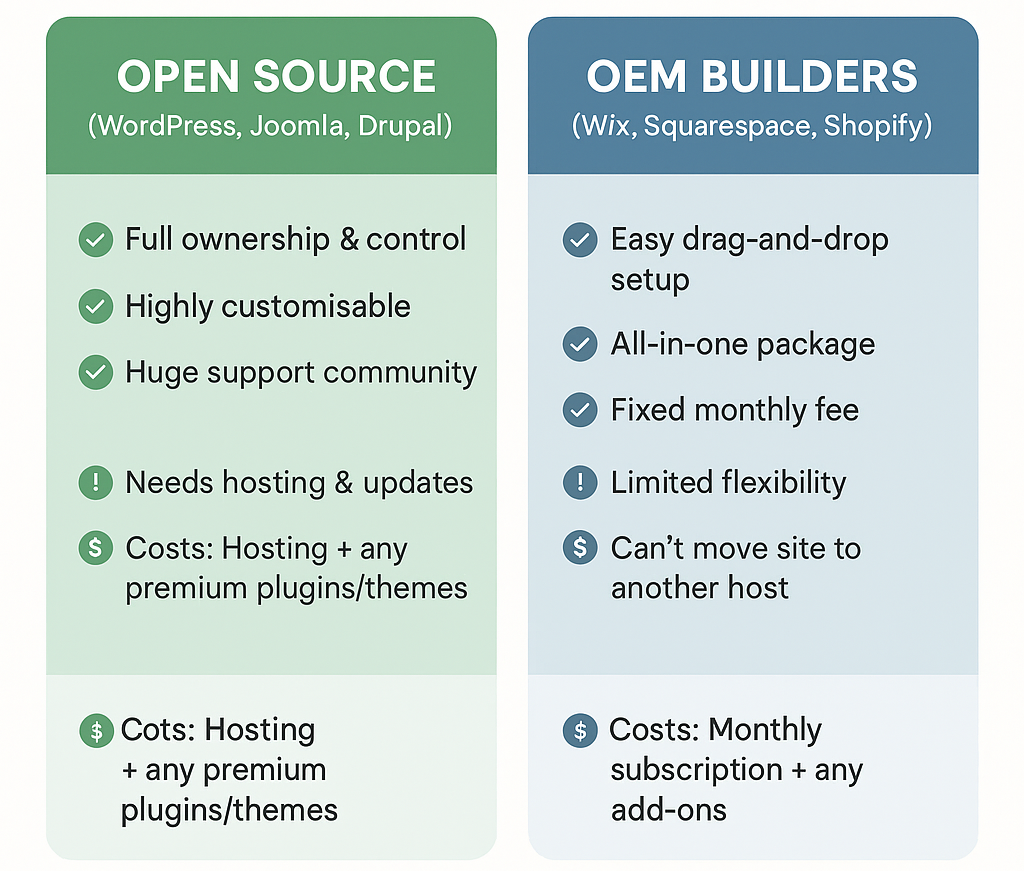Choosing the Right Website Platform: Open Source vs OEM Builders.
When it comes to building a website for your business, there’s no shortage of platforms available.
From fully open-source solutions to closed, subscription-based services, the decision you make now will impact your costs, flexibility, and growth options for years to come. Below, we’ll break down the differences, including key pros, cons, and cost considerations.
Open Source (WordPress, Joomla, Drupal) v OEM Builders (Wix, Squarespace, Shopify)
1. Open Source Platforms
Examples: WordPress, Joomla, Drupal, Magento, OctoberCMS.
What they are:
Open-source platforms are free to download and use. The source code is open to everyone, which means you (or your developer) can fully customise the site to suit your needs.
Pros:
- Complete ownership & control – No platform lock-in; move your site to any compatible hosting provider.
- Extensive customisation – Thousands of plugins, themes, and integrations available.
- Large support communities – Plenty of tutorials, forums, and developers familiar with the software.
- Long-term scalability – Ideal for growing businesses with evolving needs.
Cons:
- Requires hosting & maintenance – You’re responsible for updates, security patches, and backups.
- Can require technical knowledge – Non-technical users may need a web developer’s help.
- Costs vary – While the software is free, hosting, premium plugins, and developer time can add up.
Cost range:
Hosting: $10–$50+/month
Premium themes/plugins: $50–$500/year (optional)
Development: Variable depending on requirements.
2. OEM / Proprietary Website Builders
Examples: Wix, Squarespace, Shopify, GoDaddy Website Builder.
What they are:
Closed-platform solutions that bundle hosting, design tools, and technical upkeep into one monthly or annual subscription.
Pros:
- Easy setup – Drag-and-drop interfaces make it beginner-friendly.
- All-in-one – Hosting, security, and updates handled for you.
- Predictable pricing – Fixed monthly fees for the chosen plan.
- Built-in features – Some include e-commerce, booking, or marketing tools out of the box.
Cons:
- Limited flexibility – Customisation is restricted to the platform’s features and templates.
- Platform lock-in – You can’t move your site to another provider without rebuilding it.
- Ongoing subscription costs – Stop paying and your website goes offline.
- Extra fees for growth – Additional costs for more bandwidth, storage, or advanced tools.
Cost range:
Basic sites: $15–$40/month
E-commerce: $40–$100+/month (plus transaction fees)
Which is Right for You?

Go Open Source if you want full control, ownership, and the flexibility to customise without platform restrictions. Best for businesses planning to scale or needing unique functionality.
Choose an OEM Builder if you prioritise speed, simplicity, and low technical involvement, and you’re happy with the provided features.
Option
Open Source
OEM Builder
Full ownership & control
Easy drag-and-drop setup
*
Huge support community
*
Hosting & updates inlcuded
Highly customisable
All-in-one package
Fixed monthly fee
No limitions
Can be moved to another host
Rhye Media can help
*This option could be available via a premium plugin or an additional cost.
Whichever platform you choose, think about total cost of ownership—not just the first month. Maintenance, upgrades, and scalability matter just as much as the upfront price.
Need help choosing? I work with clients across both open-source and proprietary platforms. Contact me to discuss which solution will best fit your business, budget, and future plans.

